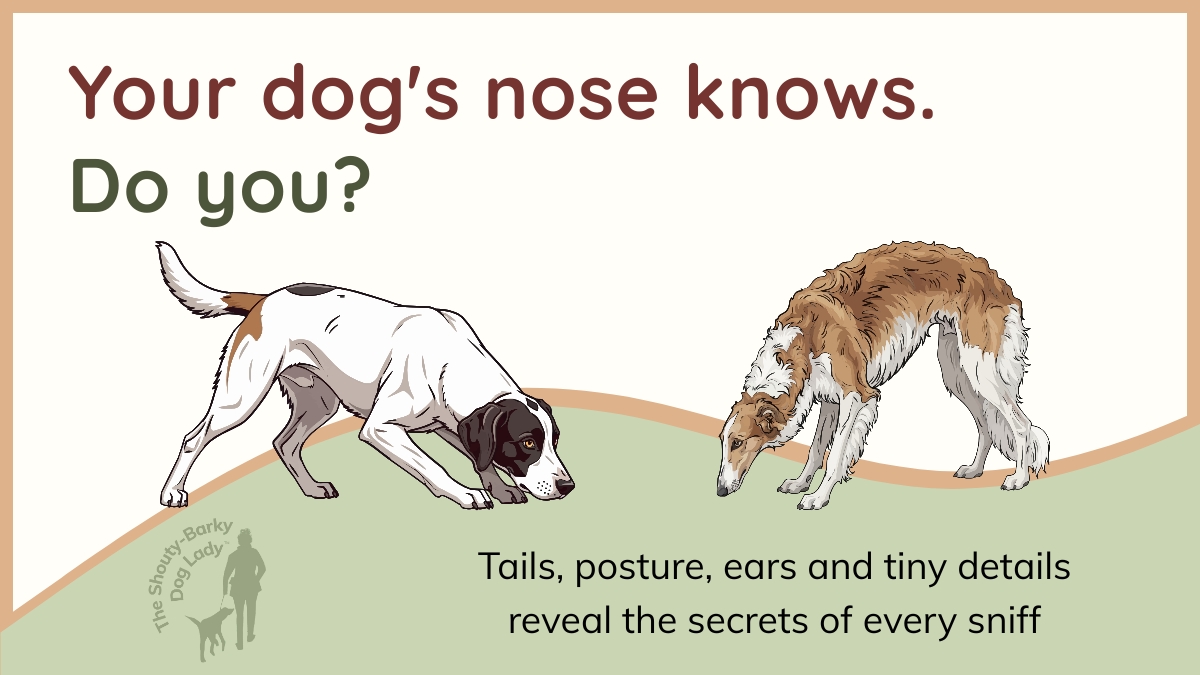What on earth has captured their attention this time?
The truth is, we’ll probably never know exactly what their nose has picked up. But we can learn a huge amount from the way their body language changes when they sniff. Dogs don’t just use their noses - their whole bodies get involved in the conversation.
Recently in the Shouty-Barky Dog Group, I asked whether people could tell what their dogs were smelling just from their body language. The answers were brilliant...
- One member’s dog worked up and down a short stretch of road with her very specific “cat/neighbour’s dog” body language, refusing to move on. This wasn’t just a passing scent and she eventually uncovered blood spatter, later confirmed to be from a cat. It was very sad news for the cat and family, and remarkable to see how determined and thoughtful the dog was, and how closely her caregiver followed the “cogs turning” as she pieced it all together.
- Someone else said their dog is a “connoisseur of fine wine” when sniffing dog wee - slowly and carefully savouring it - but if it’s prey, the nose works so hard you can hear it, with a rhythmic tail wag to match.
- And then there’s the barbecue detector dog - head high, sniffing the breeze. Her body language is completely different if it’s something alive in the undergrowth, with her nose shoved in and her body slinky and low. And if it’s carnivore poo, she pulls a face!
What I love about these (and all the other) stories is how different they are, and yet each one shows a dog communicating so clearly through posture, pace, and tiny changes in expression. Tails, posture, ears, even little quirks like drooling or chattering teeth are all clues in your dog’s own language of smell.
Try this!
On your next walk, try watching for just one of those little details. You might be surprised at how much you learn by letting their nose lead the conversation.
- Is your dog cautious, excited, disgusted, or delighted?
- Ask yourself what that tells you about what they’ve found.
If you’d like more of this kind of conversation, come and join us in the Shouty-Barky Dog Group - we’d love to hear what your dog’s nose is saying.
Join the conversation here →
https://www.facebook.com/groups/theshoutybarkydoggroup
Because every sniff tells a story, and the more fluent we get in Doglish, the better we can support our dogs to feel safe, curious, and calm.
Want to Learn More?
You can join the Calmer Canines Club for a deeper dive into this topic and many others like it, with access to gentle, practical support and a full archive of resources.
👉 www.calmercanines.co.uk/club
For Professionals
Supporting caregivers to notice these small details can make a big difference. Encouraging them to describe what they see - without interpretation at first - builds observational skills and deepens trust between dog and human. It also reduces frustration on walks, helping caregivers appreciate that a “long sniff” is meaningful communication, not a delay.
These everyday examples can be powerful teaching tools, showing that every dog already has their own vocabulary of sniffing behaviours. Our role is to help caregivers learn to listen.
 Stephie Guy
Stephie Guy 
